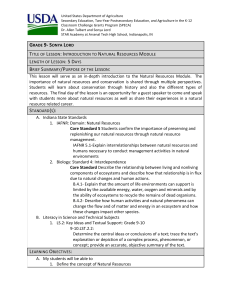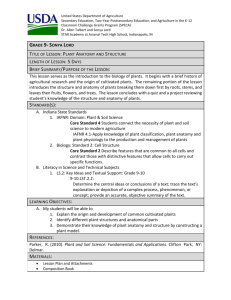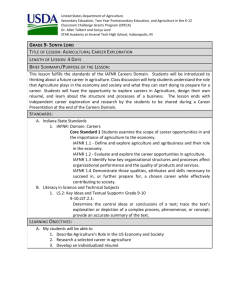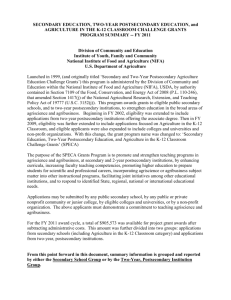IAFNR.PSS.3.LP.1.0 - NAAE Communities of Practice
advertisement
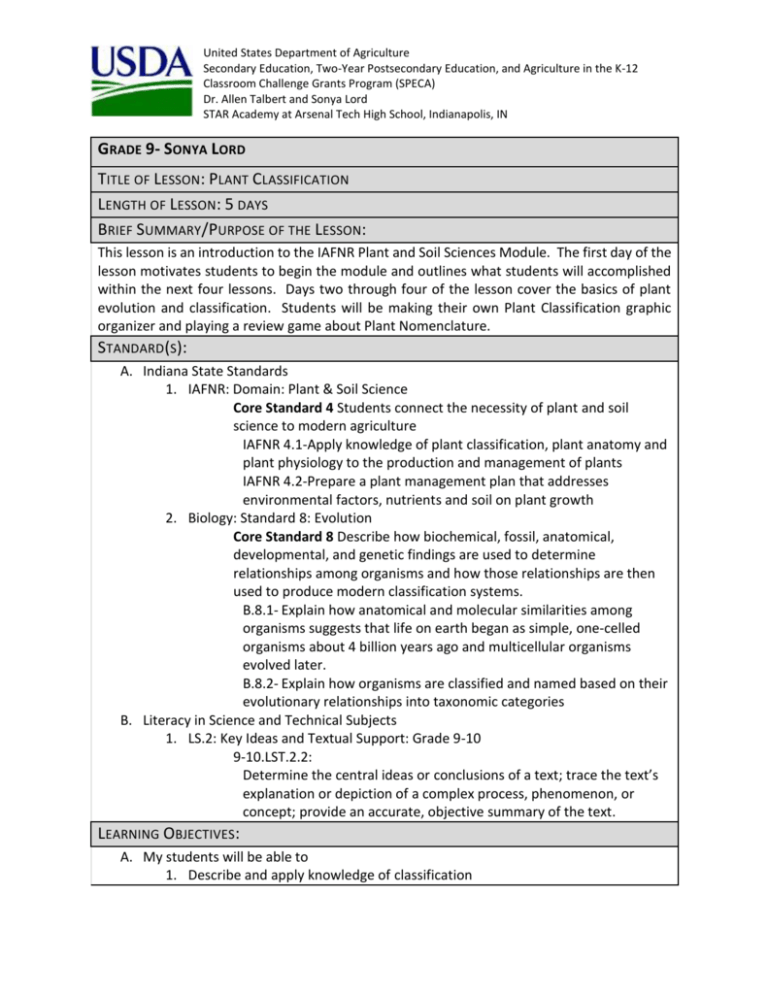
United States Department of Agriculture Secondary Education, Two-Year Postsecondary Education, and Agriculture in the K-12 Classroom Challenge Grants Program (SPECA) Dr. Allen Talbert and Sonya Lord STAR Academy at Arsenal Tech High School, Indianapolis, IN GRADE 9- SONYA LORD TITLE OF LESSON: PLANT CLASSIFICATION LENGTH OF LESSON: 5 DAYS BRIEF SUMMARY/PURPOSE OF THE LESSON: This lesson is an introduction to the IAFNR Plant and Soil Sciences Module. The first day of the lesson motivates students to begin the module and outlines what students will accomplished within the next four lessons. Days two through four of the lesson cover the basics of plant evolution and classification. Students will be making their own Plant Classification graphic organizer and playing a review game about Plant Nomenclature. STANDARD(S): A. Indiana State Standards 1. IAFNR: Domain: Plant & Soil Science Core Standard 4 Students connect the necessity of plant and soil science to modern agriculture IAFNR 4.1-Apply knowledge of plant classification, plant anatomy and plant physiology to the production and management of plants IAFNR 4.2-Prepare a plant management plan that addresses environmental factors, nutrients and soil on plant growth 2. Biology: Standard 8: Evolution Core Standard 8 Describe how biochemical, fossil, anatomical, developmental, and genetic findings are used to determine relationships among organisms and how those relationships are then used to produce modern classification systems. B.8.1- Explain how anatomical and molecular similarities among organisms suggests that life on earth began as simple, one-celled organisms about 4 billion years ago and multicellular organisms evolved later. B.8.2- Explain how organisms are classified and named based on their evolutionary relationships into taxonomic categories B. Literacy in Science and Technical Subjects 1. LS.2: Key Ideas and Textual Support: Grade 9-10 9-10.LST.2.2: Determine the central ideas or conclusions of a text; trace the text’s explanation or depiction of a complex process, phenomenon, or concept; provide an accurate, objective summary of the text. LEARNING OBJECTIVES: A. My students will be able to 1. Describe and apply knowledge of classification United States Department of Agriculture Secondary Education, Two-Year Postsecondary Education, and Agriculture in the K-12 Classroom Challenge Grants Program (SPECA) Dr. Allen Talbert and Sonya Lord STAR Academy at Arsenal Tech High School, Indianapolis, IN 2. Identify different types of plants 3. Correlate the relationship between agriculture and science REFERENCES: Bill Nye The Science Guy Full. (2014). Bill Nye the Science Guy episodes 43 Plants. Retrieved from https://www.youtube.com/watch?v=FiFA3lRFxjk. Nomenclature. (n.d.). Retrieved October 30, 2014, from http://www.merriamwebster.com/dictionary/nomenclature Parker, R. (2010). Plant and Soil Science: Fundamentals and Applications. Clifton Park, NY: Delmar. Taxonomy. (n.d.). Retrieved October 30, 2014, from http://www.merriamwebster.com/dictionary/taxonomy MATERIALS: Lesson Plan and Attachments Composition Book Writing Utensil PROCEDURES: A. Bell-Ringer 1. Day 1- Bell-Ringer Activity a. Is agriculture a science? Write down your arguments and be prepared to share with the class. 2. Day 2-Word of the Day: Classification 3. Day 3-Bell-Ringer Activity a. Two Truths and a Lie i. Students identify which of the three statements is not true a. Homo Sapiens are a species of plants b. Possibly 500,000 kinds of plants exist c. Phylogenetic is organizing plants by how they look 4. Day 4-Word of the Day: Justification 5. Day 5-Bell-Ringer Activity a. Write down any last minute questions you may have about what we have learned this week. B. Motivation 1. Introduce Module with humorous video: a. Bill Nye the Science Guy Episode 43: Plants i. https://www.youtube.com/watch?v=FiFA3lRFxjk C. Day 1 Procedure: 1. Introduce Plant and Soil Science Presentation a. What will we be learning about? b. How long will this module last? c. What kind of projects will we be doing? United States Department of Agriculture Secondary Education, Two-Year Postsecondary Education, and Agriculture in the K-12 Classroom Challenge Grants Program (SPECA) Dr. Allen Talbert and Sonya Lord STAR Academy at Arsenal Tech High School, Indianapolis, IN D. E. F. G. H. I. 2. Introduce Plant Management Project and Handout IAFNR.PSS.3.HO.1 Day 1 Closing: 1. Exit Ticket a. Write down three things you hope to learn about in out Plant and Soil Sciences module. Day 2 Procedure: 1. Plant Classification Presentation a. How did plants come about? b. What determines where plants grow? c. Uses of plants d. How are plants classified? 2. Plant Classification Chart assignment a. Students are expected to create their own graphic chart of plant kingdom classification- Due Thursday i. Must include the full classification of a. 1 Polypodiophyta b. 1 Gymnosperm c. 1 Angiosperm Day 2 Closing: 1. Exit Ticket a. Share with a partner one thing you learned today that you did not know before this class. Day 3 Procedure: 1. Plant Identification and Nomenclature Presentation a. What about the rest of the ranks? i. Family, Genus, and Species b. How do they determine the scientific name? c. What are some examples for scientific names? 2. Break class into groups and Play “Name That Plant” a. Give IAFNR.PSS.3.HO.1.1 to each group i. Groups may have ONE (student made) plant classification chart out for reference b. Use IAFNR.PSS.3.PP.1.3 to review classification and nomenclature 3. If extra time allow students to work on Plant Classification Chart Day 3 Closing: 1. Exit Ticket a. Write down any questions you may have about what we have learned about plant classification. Day 4 Procedure: 1. Begin class discussion: “Why do we classify plants?” a. Why is it important to classify/organize like this? b. When will your plant classification knowledge be useful? United States Department of Agriculture Secondary Education, Two-Year Postsecondary Education, and Agriculture in the K-12 Classroom Challenge Grants Program (SPECA) Dr. Allen Talbert and Sonya Lord STAR Academy at Arsenal Tech High School, Indianapolis, IN c. How will you use your classifying skills in the future? i. Anything can be classified or organized! 2. Writing Assignment a. In 2-3 paragraphs describe why it’s important to classify information like the plant kingdom and how you will use what you’ve learned this week in the future. 3. If students complete writing assignment in class, allow time to begin Plant Management Plans J. Day 4 Closing: 1. Exit Ticket a. Short Teacher-led review of i. Plant Classification a. Kingdom b. Lower subgroups K. Day 5 Procedure: 1. Administer Quiz 2. If time allows, guide students to begin their Plant Management Plans a. Recommend choosing 3 types of plants to include in plan L. Day 5 Closing: 1. Exit Ticket a. Write down one thing you liked about our lessons this week. ASSESSMENT: Formative: A. Plant Classification Chart B. Writing Assignment Summative: A. Plant Classification Quiz B. Plant Management Plan (Due at the end of module) SUPPORTS AND ACCOMMODATIONS FOR SPECIAL NEEDS A. IEP’s 1. Plant Classification Chart a. Assignment requirements can be modified b. Writing Disability 1. May be done with the use of technology c. Necessary Extra Assistance 1. Aide, student helper, or additional observation by instructor 2. Quiz a. Reading Disability 1. Teacher, Aid, or Student to assist in reading or pronunciation of words unfamiliar to student 2. Extra time may be allowed United States Department of Agriculture Secondary Education, Two-Year Postsecondary Education, and Agriculture in the K-12 Classroom Challenge Grants Program (SPECA) Dr. Allen Talbert and Sonya Lord STAR Academy at Arsenal Tech High School, Indianapolis, IN B. G & T 1. Projects in this lesson allow for the expansion of learning and creativity for students on an individual level
